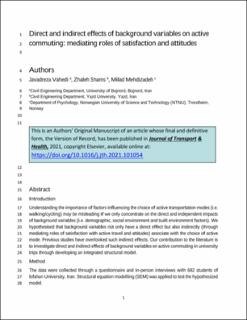| dc.contributor.author | Vahedi, Javadreza | |
| dc.contributor.author | Shams, Zhaleh | |
| dc.contributor.author | Mehdizadeh, Milad | |
| dc.date.accessioned | 2022-09-12T12:03:09Z | |
| dc.date.available | 2022-09-12T12:03:09Z | |
| dc.date.created | 2021-09-05T18:58:07Z | |
| dc.date.issued | 2021 | |
| dc.identifier.citation | Journal of Transport and Health. 2021, 21 . | en_US |
| dc.identifier.issn | 2214-1405 | |
| dc.identifier.uri | https://hdl.handle.net/11250/3017263 | |
| dc.description.abstract | Introduction
Understanding the importance of factors influencing the choice of active transportation modes (i.e. walking/cycling) may be misleading if we only concentrate on the direct and independent impacts of background variables (i.e. demographic, social environment and built environment factors). We hypothesised that background variables not only have a direct effect but also indirectly (through mediating roles of satisfaction with active travel and attitudes) associate with the choice of active mode. Previous studies have overlooked such indirect effects. Our contribution to the literature is to investigate direct and indirect effects of background variables on active commuting in university trips through developing an integrated structural model.
Method
The data were collected through a questionnaire and in-person interviews with 682 students of Isfahan University, Iran. Structural equation modelling (SEM) was applied to test the hypothesised model.
Results
The results of SEM showed that the important psychological aspects of travel (satisfaction and attitudes) mediated the link between background variables and active commuting. SEM-analysis highlighted that students who reported more positive attitudes and were satisfied with walking and cycling were more likely to commute by active modes. Female and working students were more stressed and hurried when commute by active modes, and demonstrated unfavourable attitudes towards walking and cycling, which was associated with diminished choice of active modes. Besides, students who travelled long distances or owned a private car were less likely to walk and ride bicycles.
Conclusions
Policymakers could promote the culture of active travel in the university campus through training and advertising in the mass media or launching attitude campaigns at the university scale to mitigate the current restrictions. Policymakers could also strengthen infrastructure for cycling and walking to improve student satisfaction and attitudes towards active travel modes in the study area. | en_US |
| dc.language.iso | eng | en_US |
| dc.publisher | Elsevier | en_US |
| dc.rights | Attribution-NonCommercial-NoDerivatives 4.0 Internasjonal | |
| dc.rights.uri | http://creativecommons.org/licenses/by-nc-nd/4.0/deed.no | |
| dc.title | Direct and indirect effects of background variables on active commuting: mediating roles of satisfaction and attitudes | en_US |
| dc.type | Journal article | en_US |
| dc.type | Peer reviewed | en_US |
| dc.description.version | publishedVersion | en_US |
| dc.rights.holder | This article will not be available until June 1, 2024 due to publisher embargo - This manuscript version is made available under the CC-BY-NC-ND 4.0 license | |
| dc.source.pagenumber | 13 | en_US |
| dc.source.volume | 21 | en_US |
| dc.source.journal | Journal of Transport and Health | en_US |
| dc.identifier.doi | 10.1016/j.jth.2021.101054 | |
| dc.identifier.cristin | 1931423 | |
| cristin.ispublished | true | |
| cristin.fulltext | original | |
| cristin.qualitycode | 1 | |

